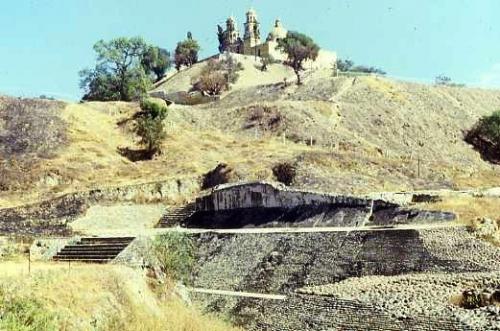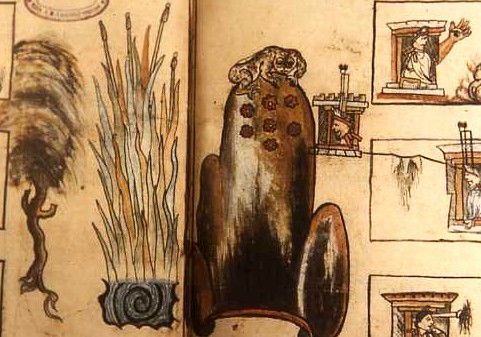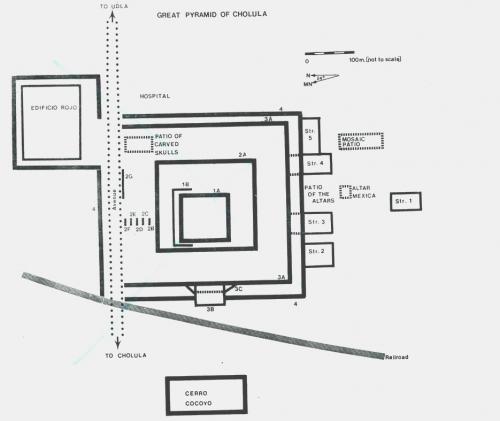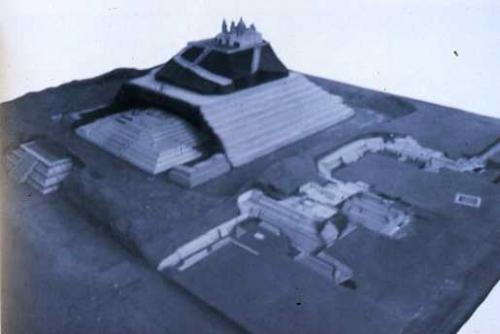The Great Pyramid
By Geoffrey McCafferty (2008)
The Great Pyramid of Cholula, known from Colonial sources as Tlachihualtepetl (Nahuatl for "artificial mountain") is the largest pyramid in the world based on volume of construction material. It measures about 65 m in height, and has been traditionally measured at about 400 m on a side. Recent investigations by Arqlgo. Sergio Suárez Cruz, however, indicate that the north/south axis may measure closer to 600 m.

Great Pyramid from southwest
Cholula was never a 'lost city' in the colloquial sense, since it was a thriving city when the Spanish arrived in 1519 and was the subject of numerous Colonial accounts. While the Pyramid had been replaced as the ceremonial center of the city by the Late Postclassic Pyramid of Quetzalcoatl, it was nevertheless an important part of the ritual landscape. For example, Motolinia recorded that it was still a shrine to a rain deity, Chiconauquiahuitl, and hundreds of Late Postclassic burials suggest that the pyramid served as a cemetery. The Historia Tolteca-Chichimeca depicts the Tlachihualtepetl as it probably looked in the early 1500s, when Cortés described it as an overgrown hill where rabbits and snakes lived.

Tlachihualtepetl (Historia Tolteca-Chichimeca, folio )
Early European visitors to Cholula recorded various accounts of the mound. For example, Alexander von Humboldt took measurements in the late 18th century, and Edward B. Tylor noted that the monochrome pottery on the interior of the mound was distinctive from the polychrome pottery on the surface, suggesting that they were made by different groups. One of the most detailed descriptions is still that of Adolph Bandelier (1884), who recorded characteristics that have now been lost to recent development.

Great Pyramid as it looked c. 1820 ( )
Scientific investigations of the Great Pyramid began in the 1930s as the Proyecto Cholula, under the direction of Ignacio Marquina, one of the premier architectural historians of the 20th century. In two major phases over nearly 50 years some of the finest Mexican archaeologists conducted extensive excavations into and around the Pyramid. Investigations included 8 km of tunnels throughout the Pyramid to identify different stages of construction, and extensive excavations on the south and west sides to expose late facades and attached platforms. Since the 1970s investigations at the Great Pyramid have been limited to brief rescue operations by archaeologists from the Puebla center of the Instituto Nacional de Antropología e Historia.
One of the weaknesses of Cholula research has traditionally been the lack of publication. The Proyecto Cholula is reported in only a handfull of articles, most collected into a volume edited by Marquina (1970). Consequently there has been much confusion over the construction history of the Great Pyramid. This has been most explicitly been addressed in a series of publications since 1996 (McCafferty 1996, 2000, and 2001). I identify four major construction stages for the Great Pyramid, as well as several partial phases which do not alter the entire pyramid footprint.

Plan of Great Pyramid construction stages
Another welcome contribution is a recent book on Cholula, edited by Felipe Solis (n.d.), that includes a useful summary of the history of investigation, a study of the mural art, and a chapter on attempts to understand the foundations of the pyramid.
The archaeological zone of Cholula currently includes the Great Pyramid itself, grounds on the south and west sides where pre-Columbian architecture has been conserved, and the site museum (Museo del Sitio) to the north. The museum features a large model of the Great Pyramid showing different stages of construction in cutaway views, as well as displays of artifacts from the site divided by time period. A back room features a reproduction of some of the polychrome murals from inside the pyramid's tunnels. A recent addition is a copy of the Codex of Cholula, a large plan of the city showing the location of various pyramid mounds, outlying communities, and of the Cholula massacre.

Model of Great Pyramid (Museo del Sitio)

Detail of Codex of Cholula showing Tlachihualtepetl

